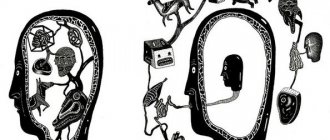What is a mind map?
The life hacker has already told us what a mind map is (also known as a thought map, mind map) and how to work with it. In short, it is a way to visualize the thinking process by creating non-linear diagrams. For example, these:
Let's select tools that will improve the process of structuring ideas. But first, let’s make sure once again that mind mapping is a useful idea.
MAJOR ERRORS when creating
Most often, when starting to work with mind maps, 5 typical errors occur:
- Information overload . If too much information is added to the intelligence circuit, it means that the information has not been analyzed;
- Simple hierarchical forms. If the mindmap form is a simple hierarchy, you're probably missing a lot of important things;
- Excessive severity . If your map is too strict, it will resemble textbook graphics and will be more difficult to perceive;
- Graphic oversaturation . It is important not to overdo it with a variety of fonts, sizes, designs and other graphic elements;
- Rare interaction . Mind maps are only effective if they are constantly available to you.
So, if you want to get the most out of this tool, be sure to check the final map for errors.
WE ARE ALREADY MORE THAN 32,000 people. TURN ON
In-scale / marketing
Who will the mind map help and how?
- Writers, screenwriters and editors: put things in order in your head, take into account all the details so that the result does not have to be destroyed or rewritten.
- For businessmen and startupers: create a clear script for a presentation or pitch; display long-term and urgent projects that have many subtasks, be it the launch of a new project on the market or an annual report.
- For schoolchildren and students: navigate the flow of educational information and better remember the material for the exam, write a diploma that you will be proud of.
- For scientists and teachers: schematically organize the structure of the lesson on the board or in a presentation, think over the plan for a new scientific article.
- For those who have embarked on the path of self-development: analyze strengths and weaknesses, put together and visualize all plans and dreams.
A mind map will help those whose personal and professional tasks require planning, ordering and structuring.
List of the best tools for creating mind maps in 2022
- Coggle (Web) - for beginners;
- Mindly (macOS, iOS, Android) - for mobile;
- Draw.io (Web, macOS, Linux, Windows, Chrome OS) - free;
- iMindMap (macOS, Windows, iOS) - for in-depth analysis of the mind map;
- MindMup (Web) - for creating public mind maps;
- MindMeister (Web, iOS, Android, macOS, Windows) - for team work;
- Scapple (macOS, Windows) - for those who love flexible settings and unusual display of mind maps;
- SmartDraw (Web) - for linear mind maps;
- Stormboard (Web) - for personal use;
- SimpleMind (macOS, Windows, iOS, Android) - for creating mind maps from PDF files;
- LucidChart (Web, iOS, Android) - for those who want to make not just a map, but a real flowchart.
Coggle (Web)
The best mind map service for beginners
When you go to Coggle you'll see the "core" where it all starts. This is your main idea.
Next, you will notice a tempting plus sign with which you can add child thoughts or nodes. Coggle selects the direction and location of the new node automatically. But you can always drag nodes and rearrange them the way you need.
For those who prefer to use a keyboard, there is a special cheat sheet for keyboard shortcuts. Finding it is easy: click on the green question mark icon in the lower right corner of the canvas page.
One of my favorite features of Coggle is the ability to format map elements and messages using Markdown. There are no limits to your imagination - you can add as many links and images as you want.
If you want to share some ideas with a friend, add them to your card and continue the conversation in the sidebar, or switch to full-screen presentation mode to dive deeper into ideas.
How much it costs : Free up to three personalized mind maps, or $5 per month for unlimited mind maps and additional tools (like additional shapes and color management).
Which tool to choose
Creating mental maps is such a personal endeavor. How your brain works will determine which tool is best for you. Do you sit at a desk when brainstorming, or do your best ideas come to you while you're on the go? Do you think sequentially or do ideas come to you randomly? Do you like to brainstorm with a team or on your own? Consider all of these questions and try a free trial of each of these services before committing to just one.
The article was translated by Konstantin Dokuchaev , author of the All-in-One Person . A blog about the most useful applications for your gadgets. Original article on the Zapier blog
iMindMap (macOS, Windows, iOS)
The Best Mind Mapping Tool for In-Depth Analysis
iMindMap was created in collaboration with Tony Buzan, the man who invented the method of structuring ideas and thoughts back in the 1960s. The service provides all the necessary functions for quickly creating smart maps. There are more than two dozen options (including text styles, nodes, etc.), the toolbar is a little overloaded, but all functions are available with one click.
It’s convenient that you can quickly change the map layout. There is an option to make the map temporary - in this case, it will look like a linear progression, in which you can see the time and task lists attached to it. And there is also a layout that will build everything according to a radial concept - it will break each idea into beautiful rings and half-rings. These features will make the mind map easier to navigate and make visualization enjoyable.
How much does it cost : $100 for the simplest version; from $235 for the Ultimate version, which includes a radial layout, teamwork and 3D mode.
Scapple (macOS, Windows)
The best tool for creating creative mind maps
Most mind maps require you to start with a central node and then add more nodes and subnodes, expanding as your brain comes up with new ideas and associations. The creators of Scapple decided to make it more flexible.
For example, you don't want to start your idea with a central thought - and don't. You can start with a tiny idea and then "work backwards" to find the main idea. Scapple allows this to happen in stages, since individual nodes will only connect when you start dragging one on top of the other. This way, complex systems can be sketched out very quickly without losing the flow of ideas.
Scapple's interface may seem simple compared to some other mind mapping tools. But this simplicity also allows for maximum flexibility. Real-time collaboration isn't possible, but you can store your files in the cloud and share them with other members of your team so they can edit them and save their changes.
What is the price: $14.99.
SmartDraw (Web)
The Best Tool for Linear Mind Maps
In a world of curves and circles, SmartDraw stands out for its linearity. Child ideas start either to the left or right of the central node, and each subsequent child idea continues in the same direction. The benefit of this layout is that the entire map automatically changes to suit your growing ideas, and you don't have to worry about any idea disturbing someone else's space. And while the finished product may look more like a flowchart, it still follows the free-thought mind map format.
In general, this is not a matter of taste, but rather the ability to understand the logical chain of what is happening.
How much does it cost : $9.95 per user per month; There is a discount for group accounts: $5.95 per user per month (minimum number: 5 users). Disadvantage: they ask you to pay for the whole year at once.
How are they different from regular entries?
Linear notation is the main form of recording information that we use at school, university, work, and in many institutions. It is used in instructions, books, posters and everything else. Therefore, using this form seems logical, convenient and correct.
But maybe it's just a matter of habit? There are some differences between line notes and mind maps that may make it worthwhile to change your habits.
- The entire structure of vertical text information is quite difficult to see, and additional actions such as flipping or scrolling the page may be required to view everything. And the maps are built on a circular principle, and with one glance you can take in everything that is depicted.
- The linear list is not “psychologically” complete; it can be continued, which prevents us from perceiving it holistically. The finished map has all the elements in place, it is thought out, composed and cohesive.
- Our brain is not the best at remembering monotonous notes, as opposed to various pictures, colorful branches and colorfully designed keywords.
- In ordinary notes it is quite difficult to highlight the most important idea; it is lost in numerous lists, highlighted and underlined words. On a mental map, the main object of study is always in the center, and it is from this that secondary branches and additional information diverge.
- Since we use visualizations when constructing a mental map, the right hemisphere of the brain is used, which is responsible for aesthetics and thinking about the problem as a whole. It is because of this that we can think about what is shown on the map from different angles. With linear recordings, such involvement of the right hemisphere of the brain is minimal.
- Linear notes take a lot of time, because a person does not write very quickly by hand. We have to shorten the words; they are not always written clearly, and this is to the detriment of the quality of the recordings.
Application area
The scope of application is limitless (limited only by your imagination). Mental maps are used in different areas of life. Main application examples:
- Connection diagrams are used to sort chaotic thoughts into pieces. For example, with their help you can describe the content of a future novel, reflecting all the plot tricks and the author’s techniques.
- Ready-made diagrams can be inserted into presentations so that listeners can visually perceive and quickly remember the presentation material.
- Collective intelligence can be used to create a diagram. This is how brainstorming sessions are now conducted in many large corporations.
- Before the exam, it is very useful to structure all the knowledge you have learned in order to finally understand why all this was taught to you.
- In time management: a connection diagram allows you to plan things for a year, five years, a month, a week and a specific date.
- Helps you make decisions and solve everyday problems.
- You can plan business development, achieve a goal, perform work or household tasks, travel, vacation, event, move, you can even plan a budget. Mental maps help develop thoughts, the emergence of associations and new ideas.
- Recording information. Mental maps are a convenient form of recording data that allows you to present it in a succinct form even with a large volume.
- Memorizing information. When you write something down in a convenient, easy form, it automatically sticks in your head.
- Easy access to information. Data recorded in the form of mental maps is easy to recall even after just one glance.
- Information analysis. The mental map is built in such a way that it allows you to see previously unnoticed connections between its parts, small unaccounted for details, which can be very valuable when making decisions. Also, with its help, you can look at all the information as a whole, comprehensively, which generally helps to understand the topic and better understand this data.
Mental maps help you easily process information, which makes them very useful in many areas of our lives:
Why use it?
Mental maps help when working with any data, improve the brain’s ability to perceive information, but why?
The first reason lies in the construction of the map itself - it is depicted in a radial form, the key image is in the center, and further branches diverge from it. This simplifies the supply of information to the brain - after all, we also see the world around us as a whole - the central image and the details around it.
The second reason also lies in the processing of information by our brain - visualization in general improves perception. We remember words with pictures 6 times better than just words.
When constructing a mental map, various abilities of our thinking are activated. When compiling branches and keywords, we use hierarchies, for pictures - visualization and associative thinking, in general, spatial-figurative thinking is used. All this activates memory and allows you to remember both the structure of the data and its important aspects, so the use of mental maps improves the memorization of information by about 32%. Since we use various thinking abilities to build mental maps, such as creativity, logic, imagination, they all develop and improve in the process.
Since mental maps show the whole picture, it allows you to establish all the relationships between objects, even if they were not so obvious initially. In turn, this leads to a new perspective on the information, as well as new ideas and thoughts. The structure and logic of data become more “transparent”, easier to understand and remember.
Another undeniable argument in favor of using mental maps is that it is very easy to learn this technique, and you can remember information with its help immediately, in large quantities and very effectively. In this case, you have to write little, which significantly saves time.
MindMup (Web)
The best tool for creating public mind maps
The MindMup toolbar is easy to use, with quick links for all your basic needs - from changing the color of each node to adding detailed text and attaching a file. However, the service stands out among its competitors due to its other capabilities.
Many mind map services require at least an email address to work, but MindMup allows you to create mind maps and share them with other users without even logging in. The free cards are automatically deleted after six months, but if you're using it for a short-term project, this is a great option. You can also install the Google Drive add-on to enhance sharing and team collaboration.
How much does it cost : free for cards up to 100 KB; from $2.99 per month for MindMup Gold, which includes large maps and teamwork.
Draw.io (Web, macOS, Linux, Windows, Chrome OS)
The best tool for lovers of free services
Draw.io lets you draw and create almost anything, including mind maps.
The service allows you to add shapes, links, text and images, as well as change colors, connect ideas using lines, and so on. Since the tool is designed not only for mental maps, you will have to work hard and do everything manually: add idea elements, connect them with lines and rearrange them so that everything fits well into the base. Some users, on the other hand, like it because it gives them freedom, which means they can find new and unexpected correlations between ideas.
You can use the web version directly from your browser, without even logging into your account. You can download a separate program and work outside the browser. In any case, you will have to put up with advertising - it is this that gives free access to all functions in free mode, even the teamwork function.
How much does it cost : free.
Consciousness, unconsciousness, self-awareness
4.1. Concept
4.1.1. Structure
4.1.2. Functions according to Lomov
4.2. Types of states of consciousness
4.3. Characteristics according to Freud
4.3.1. Conscious
4.3.2. Preconscious
4.3.3. Unconscious
4.4. Personality defense mechanisms according to Freud
4.5. Characteristics of unconscious automatisms, the phenomenon of unconscious attitudes, unconscious accompaniments of conscious actions
4.6. Personality structure according to Freud
4.7. Methods for studying the unconscious
4.8. Characteristics of supraconscious processes
4.9. Self-awareness. Structure of the self-image
4.10. Self-esteem and level of personality aspirations
LucidChart (Web, iOS, Android)
The best tool for organizing your mind map
LucidChart is good for creating so-called flowcharts, which have a clearly organized symmetrical branching. It includes all the elements needed to create a mind map, but also allows you to rework and refine your ideas into an organized and detailed flowchart. The map itself is easy to make: you simply drag shapes on the canvas and then connect them with lines.
Once you've created your base map, you can use other LucidChart features to flesh out your ideas and fine-tune the connections between them. For example, you'll want to bring in some data and automate the next steps in your project, whether that's generating a UML sequence diagram, importing CSV files, or linking objects in the diagram to data that exists in Google Sheets.
In short: if you need to turn your map into something more technical, LucidChart gives you all the tools you need to do it.
By the way, LucidChart can read files from other similar services, such as Microsoft Visio, Gliffly and Omnigraffle.
How much does it cost : there is a free option (allows you to create no more than 3 mental maps); from $4.95 per month for the basic plan, which includes an unlimited number of forms and documents.










